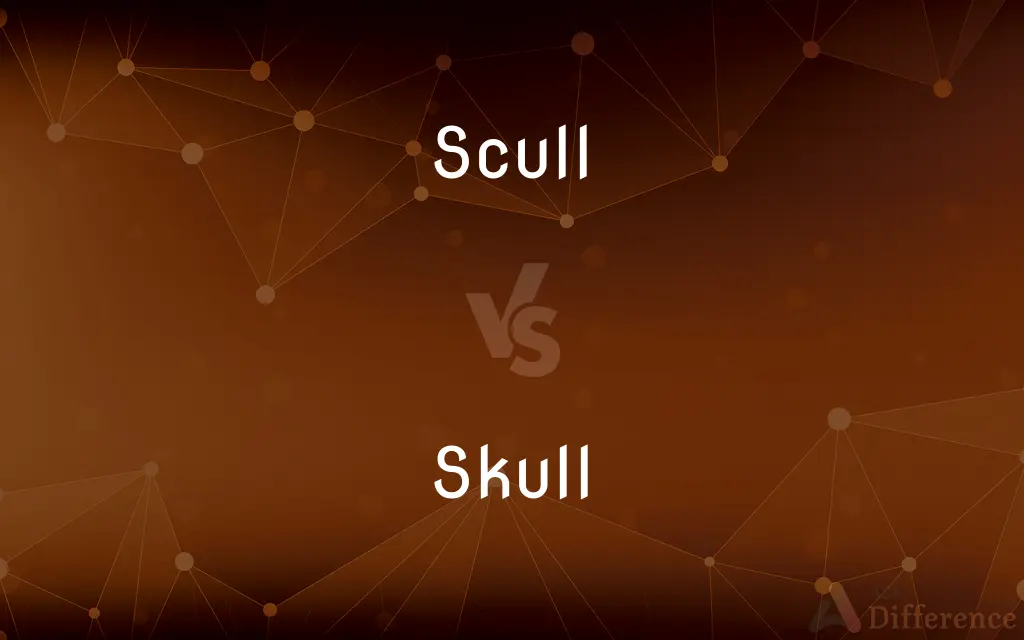Scull vs. Skull — What's the Difference?
By Urooj Arif & Maham Liaqat — Updated on March 15, 2024
Scull refers to a type of oar or the action of rowing with such oars, while skull is the bone structure forming the head, protecting the brain.

Difference Between Scull and Skull
Table of Contents
ADVERTISEMENT
Key Differences
Scull is primarily associated with watercraft and rowing, where it can denote either a type of small, narrow boat or the oars used in sculling, which is a method of rowing where a person uses two oars, one in each hand. Sculling is a technique that allows for precise control and is often seen in competitive rowing and recreational boating. On the other hand, the skull is a term from anatomy, referring to the bone structure that makes up the head, enclosing and protecting the brain and supporting the structures of the face.
The scull, in its role as part of watercraft, is essential for propulsion and maneuvering in the water, being a key element in the sport of rowing, where athletes might compete in sculling events. The skull, however, plays a crucial role in the protection of the brain, one of the most vital organs in the body, and is studied extensively in fields like medicine, anthropology, and archaeology for insights into health, evolution, and historical lifestyles.
While sculls are crafted by manufacturers who specialize in boating and sporting equipment, focusing on materials that enhance buoyancy, durability, and speed, skulls are studied by medical professionals, biologists, and anthropologists to understand more about human and animal physiology, evolution, and history.
Sculling as an activity can be a leisure pursuit, a form of exercise, or a competitive sport, attracting individuals interested in water sports and rowing. In contrast, the study of skulls can lead to important discoveries in various fields, including medical research, forensic science, and historical investigation, reflecting the diverse implications of these terms.
Despite the complete difference in their meanings and contexts, both scull and skull contribute significantly to their respective fields, whether it be in the realm of sports and recreation or in the study of biological and anthropological sciences.
ADVERTISEMENT
Comparison Chart
Definition
A type of oar for rowing or the action of rowing with such oars
The bone structure forming the head, enclosing the brain
Context
Watercraft, rowing, and sports
Anatomy, medicine, anthropology, archaeology
Role
Propulsion and maneuvering in water
Protection of the brain, support for facial structures
Associated Professionals
Boat manufacturers, rowers, sports enthusiasts
Medical professionals, biologists, anthropologists
Purpose
Leisure, exercise, competitive sport
Study in health, evolution, historical lifestyles
Compare with Definitions
Scull
A narrow, oar-driven boat used in the sport of rowing.
She trained rigorously in her scull for the upcoming regatta.
Skull
The bone structure of the head that encloses the brain and forms the face.
The human skull includes the cranium and the mandible.
Scull
One of a pair of short oars used in sculling, each managed by one hand.
He adjusted his grip on the sculls, focusing on his rowing technique.
Skull
In broader terms, skull can refer to the head as a whole, including its contents.
Wearing a helmet protects the skull during potentially dangerous activities.
Scull
The action or technique of rowing with a scull or sculls.
Sculling requires precise coordination and balance.
Skull
In anthropology or archaeology, a skull can provide valuable insights into ancient human life.
The discovered skull was examined to determine characteristics of early human ancestors.
Scull
In a broader sense, sculling can refer to any small boat rowed with this method.
They spent the afternoon sculling around the calm lake.
Skull
Artistically, skulls can symbolize mortality or be used in fashion and design.
The artist incorporated a skull motif into his series on the theme of life and death.
Scull
A racing boat designed for one, two, or four rowers, each using a pair of sculls.
The four-person scull team prepared for the national championships.
Skull
Skulls are studied in medicine and biology to understand brain protection and facial structure.
Surgeons study the skull extensively to perform safe and effective cranial surgeries.
Scull
Each of a pair of small oars used by a single rower.
Skull
The skull is a bone structure that forms the head in vertebrates. It supports the structures of the face and provides a protective cavity for the brain.
Scull
A large group of fish which has migrated from the open sea to inshore waters.
Skull
A bone framework enclosing the brain of a vertebrate; the skeleton of a person's or animal's head
He broke his collar bone and fractured his skull
Scull
Propel a boat with sculls
He built boats and taught the gentlemen how to scull
Skull
Hit (someone) on the head
My waking came in drugged stages—I had been skulled
Scull
A long oar used at the stern of a boat and moved from side to side to propel the boat forward.
Skull
The bony or cartilaginous framework that encloses and protects the brain and sense organs of all vertebrates and of one group of nonvertebrates (the hagfishes); cranium.
Scull
One of a pair of light oars designed for use by a single rower.
Skull
(Informal)The head, regarded as the seat of thought or intelligence
Use your skull and solve the problem.
Scull
A small light racing boat for one, two, or four rowers, each using a pair of sculls.
Skull
(anatomy) The main bones of the head considered as a unit; including the cranium, facial bones, and mandible.
Scull
To propel (a boat) with a scull or a pair of sculls.
Skull
(figuratively) The mind or brain.
Scull
To use a scull or a pair of sculls to propel a boat.
Skull
A crust formed on the ladle, etc. by the partial cooling of molten metal.
Scull
To generate propulsion, as in swimming, with a motion resembling that of a single scull oar.
Skull
The crown of the headpiece in armour.
Scull
A single oar mounted at the stern of a boat and moved from side to side to propel the boat forward.
Skull
(Scotland) A shallow bow-handled basket.
Scull
One of a pair of oars handled by a single rower.
Skull
Obsolete form of school
Scull
A small rowing boat, for one person.
Skull
To hit in the head with a fist, a weapon, or a thrown object.
Scull
A light rowing boat used for racing by one, two, or four rowers, each operating two oars (sculls), one in each hand.
Skull
To strike the top of (the ball).
Scull
Obsolete form of skull
Skull
A school, company, or shoal.
A knavish skull of boys and girls did pelt at him.
These fishes enter in great flotes and skulls.
Scull
A skull cap. A small bowl-shaped helmet, without visor or bever.
Skull
The skeleton of the head of a vertebrate animal, including the brain case, or cranium, and the bones and cartilages of the face and mouth. See Illusts. of Carnivora, of Facial angles under Facial, and of Skeleton, in Appendix.
Scull
(obsolete) A shoal of fish.
Skull
The head or brain; the seat of intelligence; mind.
Skulls that can not teach, and will not learn.
Scull
The skua gull.
Skull
A covering for the head; a skullcap.
Let me put on my skull first.
Scull
To row a boat using a scull or sculls.
Skull
A sort of oar. See Scull.
Scull
To skate while keeping both feet in contact with the ground or ice.
Skull
The bony skeleton of the head of vertebrates
Scull
To drink the entire contents of (a drinking vessel) without pausing.
Scull
The skull.
Scull
A shoal of fish.
Scull
A boat; a cockboat. See Sculler.
Scull
The common skua gull.
Scull
To impel (a boat) with a pair of sculls, or with a single scull or oar worked over the stern obliquely from side to side.
Scull
To impel a boat with a scull or sculls.
Scull
A long-handled oar mounted at the stern of a boat and moved left and right to propel the boat forward
Scull
One of a pair of short-handled oars
Scull
A racing shell propelled by one or two oarsmen pulling two oars
Scull
Propel with sculls;
Scull the boat
Common Curiosities
Is the skull considered a single bone or a collection of bones?
The skull is a collection of bones, including the cranium (which encloses the brain) and the facial bones, but it is often referred to as a single entity for simplicity.
How do medical professionals use knowledge of the skull in their practice?
Knowledge of the skull is crucial in many medical fields, including neurosurgery, dentistry, and forensic pathology, for treatment, surgery, and identification purposes.
Can the term "scull" be used interchangeably with "row"?
While "scull" specifically refers to rowing with a pair of oars, one in each hand, "row" is a more general term that can include sculling but also refers to other forms of rowing.
Do all animals have skulls?
Most vertebrate animals have skulls, which protect the brain and sensory organs, but the structure and complexity vary widely across species.
Can "scull" refer to a type of rowing competition?
Yes, "scull" can refer to both the act of rowing with sculls and the competitions in which these types of boats are used.
What innovations have been made in the design of sculls for competitive rowing?
Innovations in scull design include improvements in materials, such as carbon fiber, for lighter and more aerodynamic boats, enhancing speed and performance.
Is sculling considered a physically demanding sport?
Yes, sculling is physically demanding, requiring strength, endurance, and coordination, making it both a challenging and rewarding sport.
Are sculls used only in competitive rowing?
No, sculls are used in competitive rowing, recreational boating, and as a form of exercise, offering versatility in their use.
What significance do skulls have in cultural or historical contexts?
Skulls can have significant cultural, religious, or symbolic meanings, representing mortality, ancestors, or used in art and rituals.
How are skulls studied in archaeology?
In archaeology, skulls are studied to understand aspects of ancient human life, including health, diet, social structure, and evolutionary history.
Share Your Discovery

Previous Comparison
Sufficient vs. Efficient
Next Comparison
Stream vs. CurrentAuthor Spotlight
Written by
Urooj ArifUrooj is a skilled content writer at Ask Difference, known for her exceptional ability to simplify complex topics into engaging and informative content. With a passion for research and a flair for clear, concise writing, she consistently delivers articles that resonate with our diverse audience.
Co-written by
Maham Liaqat














































